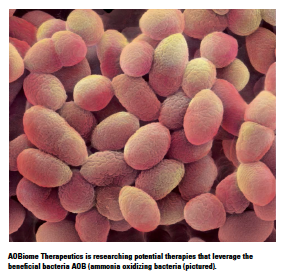Restoring the Microbiome
Todd Krueger, President and CEO of AOBiome Therapeutics, discusses the company’s research to develop therapies that aim to re-introduce beneficial bacteria to the microbiome.
 The human microbiome consists of trillions of microorganisms that live in and on humans and are essential to human health. The human microbiome isn’t just one community of microorganisms, but can be thought of as a collection of diverse communities throughout the body, for example the gut or skin microbiomes.
The human microbiome consists of trillions of microorganisms that live in and on humans and are essential to human health. The human microbiome isn’t just one community of microorganisms, but can be thought of as a collection of diverse communities throughout the body, for example the gut or skin microbiomes.
Until recently, studies of human-associated bacteria have almost exclusively focused on pathogens studied in isolation from the overall microbiome. While there are indeed pathogenic members of the microbiome, the vast majority of the members of these microbial communities are not only non-pathogenic or can only become pathogenic under specific conditions, but they can provide potential benefit to their human host.
Furthermore, when these communities of microorganisms are imbalanced, there can be a wide range of impacts on human health. Unfortunately, due to the widespread use of surfactants, antimicrobials, antibiotics, and a general trend toward sanitizing the environments we live and work in, these imbalances have become commonplace. At the same time, the incidence rates of systemic and inflammatory diseases have risen dramatically in recent history.
AOBiome Therapeutics is researching potential therapies that aim to re-introduce beneficial bacteria such as ammonia oxidizing bacteria (AOB) to the human microbiome. The company is developing a novel class of drugs for inflammatory conditions, central nervous system disorders, and other systemic diseases.
The company has shown that the presence of AOB correlates with a reduction in populations of bacteria that are commonly associated with disease, including Staph. aureus and P. acnes, which are associated with eczema and acne, respectively.
“Our bacteria is a soil-based bacteria, which we believe humans evolved with for millions of years but has essentially been eradicated from our microbiome in the last 200 years due to modern chemistry and lifestyles," says Todd Krueger, president and CEO of AOBiome.
 “Our founding scientist, David Whitlock, was on a date at a farm, and his date asked why do horses roll around in the dirt?," Mr. Krueger explains.
“Our founding scientist, David Whitlock, was on a date at a farm, and his date asked why do horses roll around in the dirt?," Mr. Krueger explains.
Dr. Whitlock, being an M.I.T. trained chemist, took the question to heart and began experimenting.
“David took a combination of artificial sweat and farm soil and let it culture together," Mr. Krueger continues. “He then took that culture and put it on himself, taking precautions to be supportive of the bacteria. David noticed that he started to feel better."
Dr. Whitlock discovered that AOB, a common bacteria found in soil and other natural environments is a critical part of the nitrogen cycle, which consumes ammonia and then produces nitric oxide and nitrite. Nitric oxide has been well-studied in the regulation of blood flow, which earned its discoverers a Nobel Prize in 1998.
Nitroglycerin, which has been used to treat chest pain due to heart ischemia since 1878, works by being converted to nitric oxide, dilating the blood vessels, decreasing heart workload, and improving heart oxygenation.
In addition to nitric oxide’s well-known anti-inflammatory and vasodilatory function, nitrite is an anti-infective, and the process that produces these products also lowers pH.
AOBiome’s research is focused on repopulating the skin or nasal microbiome with AOB. AOBiome’s product candidates use a single strain of AOB, Nitrosomonas eutropha, and have been developed with different potencies and formulations tailored to each of the company’s clinical trials.
AOBiome currently has six clinical programs with Phase II clinical trials in progress. The company also has completed a Phase II trial for the treatment of acne, and it expects to begin enrolling patients in two Phase III studies for this indication in the first half of 2019.
“Acne is generally associated with high levels of sebum, which is an oily substance present on your skin, and high levels of the bacteria P. acnes," Mr. Krueger says. “In our studies, our bacteria address both of these modalities by reducing both the amount of sebum production and P. acnes."
In addition to these results, Mr. Krueger says there were almost no side effects seen in the Phase II study, in contrast to current available treatments for acne where about 60% of patients experience side effects such as stinging or redness, and 40% experience itching.
Other programs include: a Phase II study to treat patients with eczema (atopic dermatitis), a Phase II study for the prevention of episodic migraines, a Phase II study to treat rosacea, and a Phase Ib/IIa clinical trial for the treatment of allergic rhinitis, as well as earlier-stage preclinical programs targeting a diverse set of indications where AOB may be of benefit.
Also, Mr. Krueger says the company discovered a dose-dependent response for hypertension; today, AOBiome has a Phase II program for hypertension in which AOB is delivered intranasally.
“We saw a statistically significant drop in blood pressure," he says. “We know nitrite and nitric oxide are implicated in blood pressure control, we just didn’t think spraying it on the skin would produce that type of systemic effect."
He says the company’s migraine study will also assess blood pressure, which will be used in helping to design a Phase II hypertensive study.
AOBiome is a privately held company and has raised about $100 million in financing. (PV)

















